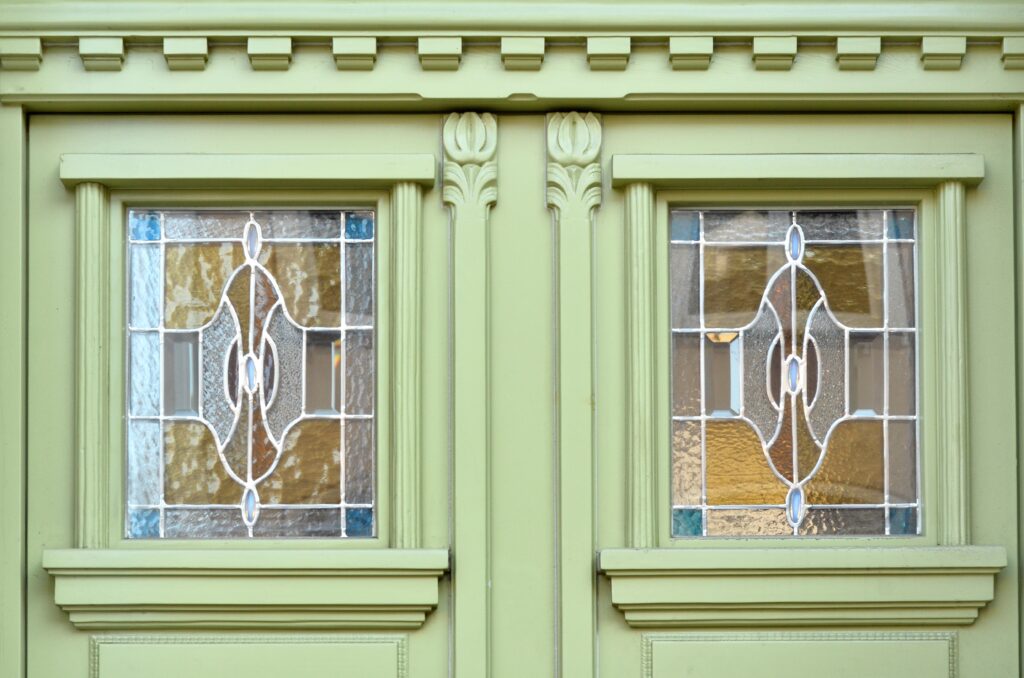Guide to Stained Glass Windows

Stained glass isn’t just for old churches or historic buildings, it’s making a stylish comeback in modern homes. With roots dating back to ancient times, stained glass has always had a way of turning sunlight into art.
Now, homeowners are rediscovering its charm, using it to add color, character, and a touch of craftsmanship to everything from entryways to bathrooms. Whether you’re into vintage vibes or sleek custom designs, stained glass offers a unique way to personalize your space.
Table of Contents
- What Are Stained Glass Windows?
- Benefits of Stained Glass Windows
- Popular Uses in the Home
- Design Styles and Inspiration
- Custom vs. Pre-Made Options
- Installation Tips and Considerations
- Maintenance and Cleaning
- Cost of Stained Glass Windows
What Are Stained Glass Windows?
At their core, stained glass windows are decorative windows made by arranging colored glass pieces into patterns or pictures—kind of like a puzzle, but way more artistic. These pieces are usually held together by strips of lead or copper foil, then sealed to create a solid, beautiful panel that can be installed in a window frame or used as a standalone feature.
There are a few different types of stained glass styles you might come across:
- Leaded stained glass is the traditional method you’ve probably seen in old churches or vintage homes. It uses lead strips (called cames) to join the glass pieces.
- Tiffany-style stained glass, made famous by Louis Comfort Tiffany, uses copper foil instead of lead, which allows for more intricate designs and curves.
- Painted stained glass involves painting details directly onto the glass, then firing it in a kiln to make the artwork permanent.
- Beveled glass isn’t colored, but it’s often included in stained glass designs for its prism-like effect and elegant look.
Each type has its own vibe, but all of them bring in light, texture, and a ton of character. Whether you’re into traditional florals or modern geometrics, there’s a stained glass style out there that fits your home’s personality.
Benefits of Stained Glass Windows
There’s a reason stained glass has stood the test of time—it’s more than just pretty to look at. These windows bring both style and function to your space.
First up: the aesthetic appeal. Stained glass instantly adds charm and personality to a room. Whether you’re going for a vintage look or something more modern and abstract, stained glass acts like a piece of art built right into your home. It draws the eye, adds visual interest, and can even complement your existing design style.
Next: privacy. One of the best things about stained glass is that it offers privacy without shutting out natural light. Frosted or textured designs make it hard for people to see in, while still letting sunshine pour through in a kaleidoscope of colors. It’s perfect for bathrooms, entryways, or any space where you want a little separation from the outside world without feeling closed in.
And let’s not forget the value it adds. Unique architectural details like stained glass can make your home stand out—especially to buyers who appreciate custom features. A well-placed stained glass window can boost curb appeal, make your interior feel more luxurious, and even bump up your resale value.
So whether you’re looking to beautify your space, keep things private, or make a smart investment, stained glass checks all the boxes.
Popular Uses in the Home
Stained glass isn’t just for grand cathedrals or old-school mansions—it fits right into today’s homes, and it’s showing up in more creative places than ever.
Entryways and sidelights are classic spots for stained glass. These areas are often front-and-center when someone walks up to your home, so why not make a statement? A stained glass panel in your front door or narrow sidelights can add instant curb appeal and set the tone for the rest of your space. Plus, it offers privacy without making the entryway feel dark or closed off.
Bathroom windows are another perfect fit. Let’s face it—nobody wants to feel exposed in the bathroom, but we still want natural light, right? Stained glass solves that beautifully. Whether you go for something colorful and bold or a more neutral, frosted design, it gives you light and privacy in one pretty package.
Kitchen accents and cabinet inserts are a fun, unexpected way to use stained glass. You can replace standard glass cabinet fronts with custom stained glass panels to add color and charm to your kitchen. It’s a great way to highlight a certain area or give an old cabinet a stylish refresh.
Custom transoms and decorative panels can be used all around the house. Think above doorways, in hallways, or even as interior room dividers. These pieces can be fully custom, reflecting your personal style or matching other design elements in your home. They bring in light, act as conversation starters, and give your space a high-end, handcrafted feel.
Design Styles and Inspiration
Stained glass isn’t one-size-fits-all—there’s a style out there for just about everyone, whether your home leans traditional or has a more modern vibe.
Traditional stained glass is what most people picture first—think rich jewel tones, floral or geometric patterns, and lots of intricate detail. This style works beautifully in older homes or spaces with a classic, vintage, or Craftsman look. You’ll often see things like roses, vines, or symmetrical patterns that give off that timeless elegance.
Modern stained glass, on the other hand, puts a fresh spin on the classic. Instead of busy designs and deep colors, you’ll find clean lines, minimal shapes, and more muted or monochromatic palettes. Clear or textured glass mixed with soft neutrals or a single accent color is a popular approach. It’s perfect for contemporary homes that want a little artistic flair without going over the top.
Color palettes and motifs can totally transform the look and feel of a stained glass window. Earthy tones like amber, green, and soft blue bring a cozy, organic feel, while bolder colors like ruby, cobalt, or even pastels can make a statement. Motifs can range from abstract shapes to natural themes like leaves, mountains, or waves.
When it comes to matching stained glass with your interior decor, the key is balance. Pull colors from your existing furniture or wall paint to tie everything together, or use stained glass as a bold focal point in an otherwise neutral room. You can even design a custom piece that complements your home’s architecture.
At the end of the day, stained glass is all about expressing your style in a way that’s both functional and beautiful.
Custom vs. Pre-Made Options
Thinking about adding stained glass to your home? One of the first choices you’ll need to make is whether to go custom or choose a pre-made panel. Both have their own perks—it’s really about what works best for your space, timeline, and budget.
When to consider custom designs:
Custom stained glass is perfect if you’re dreaming of something that’s one-of-a-kind. Maybe you want to match a specific color palette, include a meaningful design, or fit an unusual window size. A stained glass artist can help bring your vision to life and make sure it works perfectly with your home’s layout and style. It’s a great choice for statement pieces, like an entryway window, a bathroom feature, or a kitchen cabinet insert you want to show off.
Where to find ready-made panels:
If you’re looking for something more affordable—or you just want to add a little character without going all-in—ready-made panels are a fantastic option. You can find them at specialty home stores, online marketplaces like Etsy or Wayfair, antique shops, or even flea markets if you’re lucky. Some are designed to fit standard window sizes, while others are meant to be hung inside a window frame as decorative sun catchers. They’re an easy way to add charm without any major commitment.
Cost comparison:
Custom stained glass tends to be pricier, as you’re paying for the design work, materials, and craftsmanship. Depending on the size and complexity, it could range from several hundred to a few thousand dollars. Pre-made options, on the other hand, are much more budget-friendly. You can find small decorative panels starting around $50, with larger or more detailed ones in the $100–$500 range.
In the end, it comes down to what you’re going for. Want something totally unique and built for your space? Go custom. Looking for style with less hassle? Pre-made might be the way to go. Either way, stained glass is a gorgeous addition that brings personality, color, and charm to any room.
Installation Tips and Considerations
So you’ve picked out the perfect stained glass piece—now what? Whether you’re doing a full window upgrade or hanging a decorative panel, installation is a big part of making sure your stained glass looks great and lasts for years.
Professional vs. DIY installation:
If your stained glass is going into an exterior window or replacing existing glass, you’ll probably want to call in a pro. They’ll make sure it’s sealed properly, secure, and energy-efficient—especially if it needs to hold up against the elements.
But if you’re working with a smaller decorative panel or a simple interior window, a confident DIYer can definitely handle it. Just make sure to measure carefully and follow the artist’s instructions if you’re installing a custom piece.
Framing and placement tips:
A strong, well-fitted frame not only supports the weight of the glass but also protects it from damage. If you’re hanging a stained glass panel inside a window, you can use a chain or brackets and let it catch the light without altering the existing window at all. For permanent installations, you’ll want to use framing materials that match your home’s interior or exterior style—wood, metal, or even vinyl can work depending on the look you’re going for.
As for placement, think about how light hits that area throughout the day. Stained glass looks best when it’s backlit, so choose a spot that gets decent sunlight if you want those colors to really glow. Entryways, stairwells, bathrooms, and kitchen nooks are all great spots.
Working with existing window frames:
If you’re not planning to replace an entire window, you can often work with what you’ve got. Stained glass inserts can be custom-sized to fit inside your existing frame or added as a layer over the existing glass using wood or metal trim.
Just make sure your frame is in good shape—no rot, cracks, or sagging—so it can handle the weight. If it needs reinforcement, that’s something a contractor or stained glass installer can easily help with.
Maintenance and Cleaning
Stained glass may look delicate, but with the right care it can stay beautiful for decades. Keeping it clean and well-maintained doesn’t have to be complicated, but it does take a gentle touch.
How to clean stained glass safely:
First rule: skip the harsh cleaners. No ammonia, no vinegar, no abrasive sprays. These can damage the finish or weaken the lead over time. Instead, stick with a soft cloth or microfiber towel and a mix of warm water and mild dish soap. Gently wipe down the glass and the lead lines, being careful not to scrub too hard. For extra dusty or hard-to-reach areas, a soft brush works wonders.
Tips for preserving color and leading:
The vibrant colors in stained glass are baked right into the glass, so they won’t fade like paint—but they can lose their shine if dirt builds up. Try to clean your panels a couple of times a year, especially if they get a lot of sunlight or are in high-traffic areas like doors. Also, keep an eye on the leading. If it starts to look chalky, cracked, or brittle, it may need professional attention before things start to loosen or sag.
When to call a restoration expert:
If your stained glass is cracked, bowing, or has gaps between the pieces, don’t try to fix it yourself. Restoration takes a very specific skill set—professionals know how to re-solder joints, replace broken glass without affecting the design, and strengthen the structure without altering the look. It’s worth the investment, especially for antique or sentimental pieces.
Clean stained glass gently, check it now and then for signs of wear, and don’t be afraid to call in a pro if something seems off.
Cost of Stained Glass Windows
There’s a wide range of price points depending on the size, type, and whether you’re going custom or buying off the shelf.
Price ranges for various types and sizes:
Small stained glass panels can start around $50–$150. These are great for adding a pop of color without spending a ton. Medium-sized panels, like bathroom windows or transoms, usually fall in the $200–$600 range, depending on the design complexity and materials used.
Larger, more intricate pieces—like full entryway windows or large custom art panels—can easily run $1,000 and up. The more detailed the design and the bigger the piece, the higher the price.
Custom work vs. store-bought:
If you want something totally unique, expect to pay a premium for custom stained glass. You’re not just paying for materials—you’re also paying for the artist’s time and expertise. Custom work is perfect if you need an exact size, want to match a specific color palette, or have a vision in mind that you can’t find anywhere else.
On the other hand, store-bought or pre-made panels are way more affordable and still offer plenty of beauty and charm. You can find them online, at home décor stores, or even vintage shops for a fraction of the custom cost.
Budget-friendly alternatives:
There are static-cling window films that mimic the look of stained glass and can be cut to size. These are super affordable, easy to apply, and perfect for renters or anyone who wants a temporary upgrade. You can also find DIY stained glass kits if you’re feeling crafty.
No matter your budget, there’s a way to bring stained glass into your home. From affordable accents to custom showstoppers, it’s all about choosing what fits your space, style, and wallet.
Conclusion
Stained glass windows aren’t just beautiful—they’re functional, timeless, and full of personality. Whether you’re looking to add privacy without blocking sunlight, create a one-of-a-kind focal point, or just bring a little color and charm into your home, stained glass delivers on all fronts.
There’s a stained glass solution for just about every style and budget. From classic, hand-crafted panels to affordable pre-made options and even peel-and-stick designs, your dream window might be closer than you think.
If you’re ready to take the next step, consider chatting with a stained glass artist or contractor. They can help you bring your ideas to life and ensure your installation is as seamless as it is stunning. Whether it’s your front door, a bathroom window, or a kitchen cabinet insert, stained glass can be the perfect finishing touch.
FAQs
Can stained glass be used in exterior windows?
Yes! Many stained glass panels are designed to be weather-resistant and insulated for exterior use. Just make sure they’re properly sealed and framed to handle the elements.
How long does stained glass last?
With the right care, stained glass can last for decades—sometimes even centuries! Many historical pieces are still around today, looking as vibrant as ever.
Is stained glass energy efficient?
On its own, stained glass isn’t the most insulating, but you can pair it with double- or triple-pane glass for better energy efficiency. Some newer stained glass windows are built with insulating features in mind.
Additional Window Resources
- 7 Exterior Window Shutter Styles to Transform Your Home
- Benefits of Clerestory Windows
- Top Signs It’s Time to Replace Your Windows

Anna has over six years of experience in the home services and journalism industries and serves as the Content Manager at MyHomePros.com, specializing in making complex home improvement topics like HVAC, roofing, and plumbing accessible to all. With a bachelor’s degree in journalism from Auburn University, she excels in crafting localized, comprehensive guides that cater to homeowners’ unique needs. Living on both coasts of the United States has equipped her with a distinctive perspective, fueling her passion for turning any house into a cherished home through informed, personalized decision-making.
Connect with top-rated local contractors who can help you with siding, roofing, HVAC, windows, and more. Get free quotes from verified professionals in your area today.








